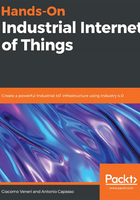
Summary
In this chapter, we learned how to implement the I-IoT data flow in a complex industrial plant. We started by looking at OPC, including what it is, how it has evolved, and how it works in both its implementations—OPC Classic and OPC UA. We explored how it connects to data sources to expose their data through common interfaces, following a common data model. We then went into detail about the edge, analyzing its features, internal components, architecture, interfaces, and current implementation.
After that, we started our journey on the I-IoT data flow. We looked at how to select a data source to connect to in order to gather data. We explored controllers, such as the PLC or the DCS, a SCADA system, and a Historian system. Each of these options has its own advantages and disadvantages; no one is better than the others. The choice must be made depending on the capabilities and constraints that exist in our plant and the requirements of our specific use case.
We then proceeded on our journey through the I-IoT data flow by analyzing the different setups for connecting the edge to selected industrial data sources. We looked in depth at five different setups, highlighting the strengths and weaknesses of each. In general, setups that use the capabilities of OPC UA are preferable, but this is not always possible, especially when dealing with old equipment. In cases such as this, the OPC Classic, with or without OPC Proxy, is the only option.
In the next chapter, we will learn how to secure these edge deployment setups from the perspective of cybersecurity.